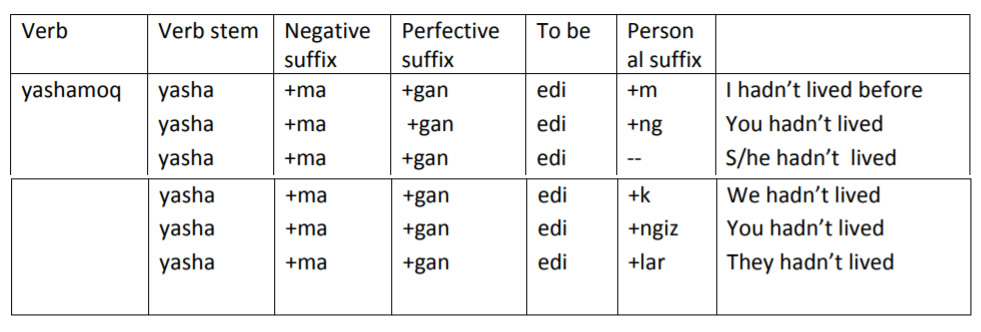Difference between revisions of "Language/Northern-uzbek/Grammar/Past-Perfect-Tense"
< Language | Northern-uzbek | Grammar
Jump to navigation
Jump to search
(Created page with " <div style="font-size:300%;"> Past Perfect Tense (Tugallangan o’tgan zamon). </div> This form is used when talking about completed action in a distant past, before the r...") |
|||
| Line 1: | Line 1: | ||
[[File:Uzbek-Language-PolyglotClub.png|thumb]] | |||
<div style="font-size:300%;"> Past Perfect Tense (Tugallangan o’tgan zamon). </div> | <div style="font-size:300%;"> Past Perfect Tense (Tugallangan o’tgan zamon). </div> | ||
Revision as of 12:02, 15 September 2021
Past Perfect Tense (Tugallangan o’tgan zamon).
This form is used when talking about completed action in a distant past, before the recent action took place. It is formed by adding edi – use to (that is the past participle), plus the possessive type of personal suffixes. The associated words with that tense are before – avval, oldin, ilgari.
For example:
- Men Fargo’onada bedana palovini yegan edim. Men Toshkentdan avval Gulistonda yashagan edim.
The negative is formed by adding to the verb stem the suffix -MA, plus the suffix -GAN, followed by the past ending edi plus the personal suffix
The negative may also be formed using the verb stem plus the suffix -GAN, followed by the negative copula emas, followed itself by the past copula edi plus the personal suffix.
- kelgan emas edim I hadn't come
- kelgan emas eding You hadn't come
- kelgan emas edi He/she/it hadn't come
- kelgan emas edik We hadn't come
- kelgan emas edingiz You hadn't come
- kelgan emas edilar / edi They hadn't come


